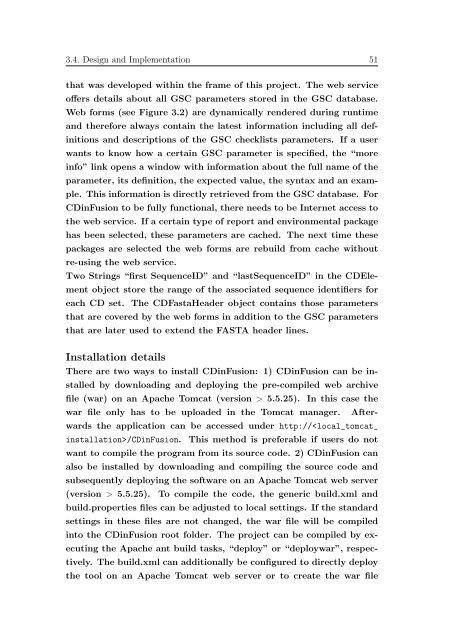Data integration in microbial genomics ... - Jacobs University
Data integration in microbial genomics ... - Jacobs University
Data integration in microbial genomics ... - Jacobs University
Create successful ePaper yourself
Turn your PDF publications into a flip-book with our unique Google optimized e-Paper software.
3.4. Design and Implementation 51<br />
that was developed with<strong>in</strong> the frame of this project. The web service<br />
offers details about all GSC parameters stored <strong>in</strong> the GSC database.<br />
Web forms (see Figure 3.2) are dynamically rendered dur<strong>in</strong>g runtime<br />
and therefore always conta<strong>in</strong> the latest <strong>in</strong>formation <strong>in</strong>clud<strong>in</strong>g all def<strong>in</strong>itions<br />
and descriptions of the GSC checklists parameters. If a user<br />
wants to know how a certa<strong>in</strong> GSC parameter is specified, the “more<br />
<strong>in</strong>fo” l<strong>in</strong>k opens a w<strong>in</strong>dow with <strong>in</strong>formation about the full name of the<br />
parameter, its def<strong>in</strong>ition, the expected value, the syntax and an example.<br />
This <strong>in</strong>formation is directly retrieved from the GSC database. For<br />
CD<strong>in</strong>Fusion to be fully functional, there needs to be Internet access to<br />
the web service. If a certa<strong>in</strong> type of report and environmental package<br />
has been selected, these parameters are cached. The next time these<br />
packages are selected the web forms are rebuild from cache without<br />
re-us<strong>in</strong>g the web service.<br />
Two Str<strong>in</strong>gs “first SequenceID” and “lastSequenceID” <strong>in</strong> the CDElement<br />
object store the range of the associated sequence identifiers for<br />
each CD set. The CDFastaHeader object conta<strong>in</strong>s those parameters<br />
that are covered by the web forms <strong>in</strong> addition to the GSC parameters<br />
that are later used to extend the FASTA header l<strong>in</strong>es.<br />
Installation details<br />
There are two ways to <strong>in</strong>stall CD<strong>in</strong>Fusion: 1) CD<strong>in</strong>Fusion can be <strong>in</strong>stalled<br />
by download<strong>in</strong>g and deploy<strong>in</strong>g the pre-compiled web archive<br />
file (war) on an Apache Tomcat (version > 5.5.25). In this case the<br />
war file only has to be uploaded <strong>in</strong> the Tomcat manager. Afterwards<br />
the application can be accessed under http:///CD<strong>in</strong>Fusion. This method is preferable if users do not<br />
want to compile the program from its source code. 2) CD<strong>in</strong>Fusion can<br />
also be <strong>in</strong>stalled by download<strong>in</strong>g and compil<strong>in</strong>g the source code and<br />
subsequently deploy<strong>in</strong>g the software on an Apache Tomcat web server<br />
(version > 5.5.25). To compile the code, the generic build.xml and<br />
build.properties files can be adjusted to local sett<strong>in</strong>gs. If the standard<br />
sett<strong>in</strong>gs <strong>in</strong> these files are not changed, the war file will be compiled<br />
<strong>in</strong>to the CD<strong>in</strong>Fusion root folder. The project can be compiled by execut<strong>in</strong>g<br />
the Apache ant build tasks, “deploy” or “deploywar”, respectively.<br />
The build.xml can additionally be configured to directly deploy<br />
the tool on an Apache Tomcat web server or to create the war file

















